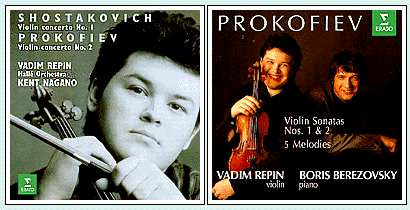REVIEW 
PROKOFIEV
Violin Concerto No. 2 in G minor, Opus 63
(1935)
SHOSTAKOVICH
Violin Concerto No. 1 in A minor, Opus 99
(1947-8)
Vadim Repin, violin
Hallé Orchestra cond. Kent Nagano
Erato 0630-10696-2 [58:59/DDD]
PROKOFIEV
Violin Sonata No. 1 in F
minor, Opus 80 (1938-46)
Violin Sonata No. 2 in D major, Opus 94b
(1943/44)
5 Melodies, Opus 35b (1920/25)
Vadim Repin, violin; Boris
Berezovsky, piano
Erato 0630-10698-2 [62:33/DDD]
Violinist Vadim Repin (born Novosibirsk, 1971) follows Maxim Vengerov (born
Novosibirsk, 1974) into the Western musical arena with an outstanding coupling of
a Prokofiev concerto with Shostakovich's First. (Vengerov's disc, replacing
Prokofiev's Second with his First, features him with the LSO under
Rostropovich [Teldec 4509-98143-2].) As with Vengerov, Repin knows what
he thinks about these scores and his way with the Prokofiev is fascinating.
This work owes its popularity to the aria-like theme of its Andante -
yet it's otherwise a mysterious piece: restless and dark and provocatively abrupt
in its ending. Emphasising the dissonance of the solo double-stopping, Repin
plays the concerto "in context" - which is to say: as the product of a period,
prior to the composer's fateful final move back to the USSR, in which his enemies
in the Composers' Union were stirring animosity against him, claiming that his
avowed intent of seeking a "new simplicity" in his music insulted the Soviet
People, whilst (simultaneously!) attacking him for élitism. At the
Composers' Union early in 1935, the principles of Socialist Realism had, for the
first time, been pitched against those of bourgeois individualism and formalism.
The Second Violin Concerto was composed a few months later.
Arguably the childishly pedantic flute arpeggios which Prokofiev uses to
accompany the first statement of the "aria" theme are a satirical reply to
his proletarian critics (mostly the same zealots that had savaged his
ballet Le pas d'acier eight years earlier). If this is so, the change, for
the restatement, to romantically sustained string chords becomes a further step
in Prokofiev's "argument" with the forces of musical reductionism in 1930s
Russia.
Once one starts to listen to the concerto in this way, its
enigmatic restlessness becomes less arbitrary. The shadowy, evasive opening
movement takes on the tone of the darker episodes in the narrative drama the
composer was writing at the same time: Romeo and Juliet. (He seems to have
designed this ballet to bypass his enemies by appealing over their heads to
ordinary listeners with music which offered instant appeal without forfeiting
expressive sophistication.) Similarly the bass-drum which paces the solo part
throughout the rhythmically irregular finale begins to sound like a somewhat
sinister ringmaster. In other words, the satire is integral. Repin is alive to
all this and Nagano supports him with his usual attention to timbre and
characterisation in the orchestral parts.
Cunningly suggestive in the
Prokofiev, Repin blazes with passion in the Shostakovich, turning in a reading of
unusual quickness (particularly in the scherzo, where Nagano and the Hallé
nevertheless manage a performance of breathtaking accuracy and clarity). Moving
more propulsively than usual in the Nocturne and Passacaglia, Repin does not
achieve Oistrakh's depth of feeling [Le Chant du Monde LDC 278882-2], but
scorches in the climactic passages, where he communicates an absolute certainty
of what the music is saying. If the laser intensity of Leonid Kogan [Russian Disc
RDCD 11025] shines brighter here, Repin's recording of this great concerto is
nonetheless among the very best.
Sleevenote writers always introduce
Prokofiev's grimly tragic F minor sonata by bringing up the composer's allusion
to Handel. Yet, while there are technical justifications for this, it's an
absurdly trivial aspect of a piece conceived at the height of Stalin's Terror and
quite obviously a direct musical reflection on this. Far from idle fantasy,
the famous "wind in a graveyard" passage in the first movement is intimately
linked to the
enormous boom in grave-digging which occurred around this time, while the three
dominant bass Cs in the second and fourth movements are as explicit a projection
of Stalinist brutality in musical terms as anything in Shostakovich's output.
Repin and Berezovsky stress this brutality, contrasting it, by means of extreme
dynamics, with the wanly elegiac moods elsewhere. Only at the beginning of the
third movement is there any hint of technical insecurity (Berezovsky's flowing
accompaniment figure). Otherwise, this is a thoroughly convincing reading as
completely in touch with the music's meaning as, for example, Gidon Kremer's
bizarrely self-regarding performance with Martha Argerich [Deutsche Grammophon
431803-2] is most certainly not.
Adapted from a flute-and-piano original
composed as light relief from war-time work on War and Peace and Ivan
the Terrible, the D major sonata is resolutely droll and radiant. Here, Repin
and Berezovsky wisely decline to sentimentalise the dotted-rhythm secondary theme
of the first movement, instead ironically inflecting it as an insouciant Parisian
amble. Recurring in the jazzy sextuplets of the third movement, this Gallic
flavour naturally dominates the Cinq Mélodies. All of these
performances are perfectly idiomatic and delightfully brought off. For the sonata
coupling, Repin and Berezovsky go to the head of the current class, their only
plausible rivals being Ashkenazy and Perlman [RCA Victor Red Seal 09026-61454-2]
and Mordkovitch and Oppitz [Chandos CHAN 8398].
Back to Reviews. Back to Contents.
